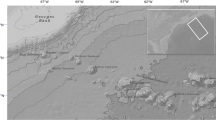Abstract
From June through September 1983, a survey was conducted to document the occurrence, abundance and distribution of benthic macroinvertebrates in the main channel, Hudson River Estuary. The survey was restricted to a 118-km reach of the limnetic zone from just below Albany to New Hamburg, New York. Results indicated that two crustacean species,Cyathura polita (Stimpson) andChiridotea almyra Bowman, are widely distributed and common throughout the limnetic zone, including areas more than 100 km upstream from the northernmost(=most upstream) intrusion of ocean-derived brackish water.Almyracuma proximoculi Jones and Burbanck was much less common, but also was found in areas well removed from any brackish-water influences. All three species previously have been thought to occur primarily in estuarine waters with at least some salinity. We could find no evidence to suggest that non-ocean derived sources were supplementing the levels of dissolved ions in the river water or sediments. Therefore, it appears that all three species have established permant populations in a truly freshwater habitat.
Similar content being viewed by others
Literature Cited
Abood, K. A. 1977. Circulation in the Hudson Estuary.Ann. NY Acad. Sci. 250:39–111.
Berner, L. M. 1951. Limnology of the Lower Missouri River.Ecology 32:1–12.
Bousfield, E. L. 1973. Shallow water gammaridean Amphipoda of New England. Cornell Univ. Press, Ithaca, New York. 312 p.
Bowman, T. E. 1955. The isopod genusChiridotea Harger, with a description of a new species from brackish waters.J. Wash. Acad. Sci. 45:224–229.
Burbanck, M. P., W. D. Burbanck, M. J. Dadswell andG. F. Gillis 1979. Occurrence and biology ofCyathura polita (Stimpson) (Isopoda, Anthuridae) in Canada.Crustaceana 37:31–38.
Burbanck, W. D. 1961. The biology ofCyathura sp., an estuarine isopod of eastern North America.Verh. Int. Ver. Theor. Angew. Limnol. 14:968–971.
Burbanck, W. D. 1962. An ecological study of the distribution of the isopodCyathura polita (Stimpson) from brackish waters of Cape Cod, Massachusetts,Am. Midl. Nat. 67:449–476.
Burbanck, W. D., andM. P. Burbanck 1979.Cyathura (Arthropoda: Crustacea: Anthuridae), p. 293–323.In C. W. Hart, Jr. and S. L. H. Fuller (eds.), Pollution Ecology of Estuarine Invertebrates. Academic Press, New York, 406 p.
Carter, S. R., K. R. Bazata, andD. L. Andersen. 1982. Macroinvertebrate communities of the channelized Missouri near two nuclear power stations, p. 147–182.In L. W. Hesse et al. (eds.), The Middle Missouri River. Missouri River Study Group, Norfolk, Nebraska, 301 p.
Crumb, S. E. 1977. Macrobenthos of the tidal Delaware River between Trenton and Burlington, New Jersey.Chesapeake Sci. 18:253–265.
Gosner, K. L. 1971. Guide to identification of marine and estuarine invertebrates. Wiley-Interscience, New York, 693 p.
Hirschfield, H. I., J. W. Rachlin, andE. Leff 1966. Invertebrates in the Hudson River, p. 220–257.In M. Eisenbud and D. B. Stevens (eds.), Hudson River Ecology. Hudson River Valley Commission, Tarrytown, New York, 325 p.
Hogan, T. M., B. S. Williams, and Z. Zo. 1973. Ecology of the estuarine isopod,Cyathura polita (Stimpson), in the Lower Hudson River, Paper No. 19.In Hudson River Ecology, Proceedings of the Third Symposium, Bear Mountain, New York. Hudson River Environmental Society, Inc.
Howells, G. P. 1972. The estuary of the Hudson River, U.S.A.Proc. Roy. Soc. London 180:521–534.
Jones, N. S., andW. D. Burbanck 1959.Almyracuma proximoculi gen. et sp. nov. (Crustacea, Cumacea) from brackish water of Cape Cod, Massachusetts.Biol. Bull. 116:115–124.
Martin, R. M. 1973. Hudson River, p. 149–174.In A. J. Van Tassel (ed.) Our Environment—The Outlook for 1980. Lexington Books, Lexington, Massachusetts, 589 p.
McFadden, J. T. (ed.). 1977. Influence of the Proposed Cornwall Pumped Storage Project and Steam Electric Generating Plants on the Hudson River Estuary, with Emphasis on Striped Bass and Other Fish Populations. Consolidated Edison Co., New York.
Remane, A., andL. Schlieper 1971. Biology of Brackish Water. Die Binnengewasser, Band XXV. John Wiley and Sons, New York. 372 p.
Ristich, S. S., M. E. Crandall, andJ. Fortier 1977. Benthos (bottom dwellers), p. 52–71.In An Atlas of the Biologic Resources of the Hudson Estuary. Estuarine Study Group, Boyce Thompson Institute for Plant Research, Yonkers New York, 104 p.
Segal, E., andW. D. Burbanck 1963. Effects of salinity and temperature on osmoregulation in two latitudinally separated populations of an estuarine isopod,Cyathura polita (Stimpson).Physiol. Zool. 36:250–263.
Simpson, K. W., J. P. Fagnani, D. M. DeNicola, andR. W. Bode 1985. The freshwater macrobenthos of the main channel, Hudson River. Part A. General study description and results, including a discussion of organism-substrate relationships. Final report to Hudson River Foundation for Grant No. 8/83A/39. Hudson River Foundation, New York, 70 p.
Smith, R. I. 1964. Keys to marine invertebrates of the Woods Hole Region. Contr. No. 11, Syst. Ecol. Program, Marine Biol. Lab., Woods Hole, Massachusetts.
Stedfast, D. A. 1982. Flow model of the Hudson River Estuary from Albany to New Hamburg, New York. US Geol. Surv., Water Resour. Inves. 81-55. Albany, New York. 69 p.
Townes, H. K., Jr. 1937. Studies on the food organisms of fish, p. 217–230.In A Biological Survey of the Lower Hudson Watershed. NYS Cons. Dept., Suppl. 26th Ann. Rep., 1936. 373 p. + Figs.
Williams, B. S., T. Hogan, andZ. Zo 1975. The benthic environment of the Hudson River in the vicinity of Ossining, New York, during 1972 and 1973.NY Fish. Game J. 22:25–31.
Author information
Authors and Affiliations
Rights and permissions
About this article
Cite this article
Simpson, K.W., Fagnani, J.P., DeNicola, D.M. et al. Widespread distribution of some estuarine crustaceans (Cyathura polita, Chiridotea almyra, Almyracuma proximoculi) in the limnetic zone of the lower Hudson River, New York. Estuaries 8, 373–380 (1985). https://doi.org/10.2307/1351875
Received:
Accepted:
Issue Date:
DOI: https://doi.org/10.2307/1351875




